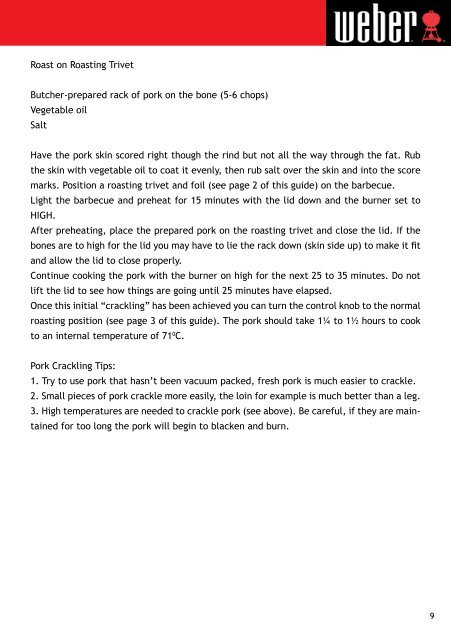Australian Cooking with the Weber® Q.TM
Australian Cooking with the Weber® Q.TM
Australian Cooking with the Weber® Q.TM
Create successful ePaper yourself
Turn your PDF publications into a flip-book with our unique Google optimized e-Paper software.
Roast on Roasting Trivet<br />
Butcher-prepared rack of pork on <strong>the</strong> bone (5-6 chops)<br />
Vegetable oil<br />
Salt<br />
Have <strong>the</strong> pork skin scored right though <strong>the</strong> rind but not all <strong>the</strong> way through <strong>the</strong> fat. Rub<br />
<strong>the</strong> skin <strong>with</strong> vegetable oil to coat it evenly, <strong>the</strong>n rub salt over <strong>the</strong> skin and into <strong>the</strong> score<br />
marks. Position a roasting trivet and foil (see page 2 of this guide) on <strong>the</strong> barbecue.<br />
Light <strong>the</strong> barbecue and preheat for 15 minutes <strong>with</strong> <strong>the</strong> lid down and <strong>the</strong> burner set to<br />
HIGH.<br />
After preheating, place <strong>the</strong> prepared pork on <strong>the</strong> roasting trivet and close <strong>the</strong> lid. If <strong>the</strong><br />
bones are to high for <strong>the</strong> lid you may have to lie <strong>the</strong> rack down (skin side up) to make it fit<br />
and allow <strong>the</strong> lid to close properly.<br />
Continue cooking <strong>the</strong> pork <strong>with</strong> <strong>the</strong> burner on high for <strong>the</strong> next 25 to 35 minutes. Do not<br />
lift <strong>the</strong> lid to see how things are going until 25 minutes have elapsed.<br />
Once this initial “crackling” has been achieved you can turn <strong>the</strong> control knob to <strong>the</strong> normal<br />
roasting position (see page 3 of this guide). The pork should take 1¼ to 1½ hours to cook<br />
to an internal temperature of 710C. Pork Crackling Tips:<br />
1. Try to use pork that hasn’t been vacuum packed, fresh pork is much easier to crackle.<br />
2. Small pieces of pork crackle more easily, <strong>the</strong> loin for example is much better than a leg.<br />
3. High temperatures are needed to crackle pork (see above). Be careful, if <strong>the</strong>y are maintained<br />
for too long <strong>the</strong> pork will begin to blacken and burn.<br />
9





